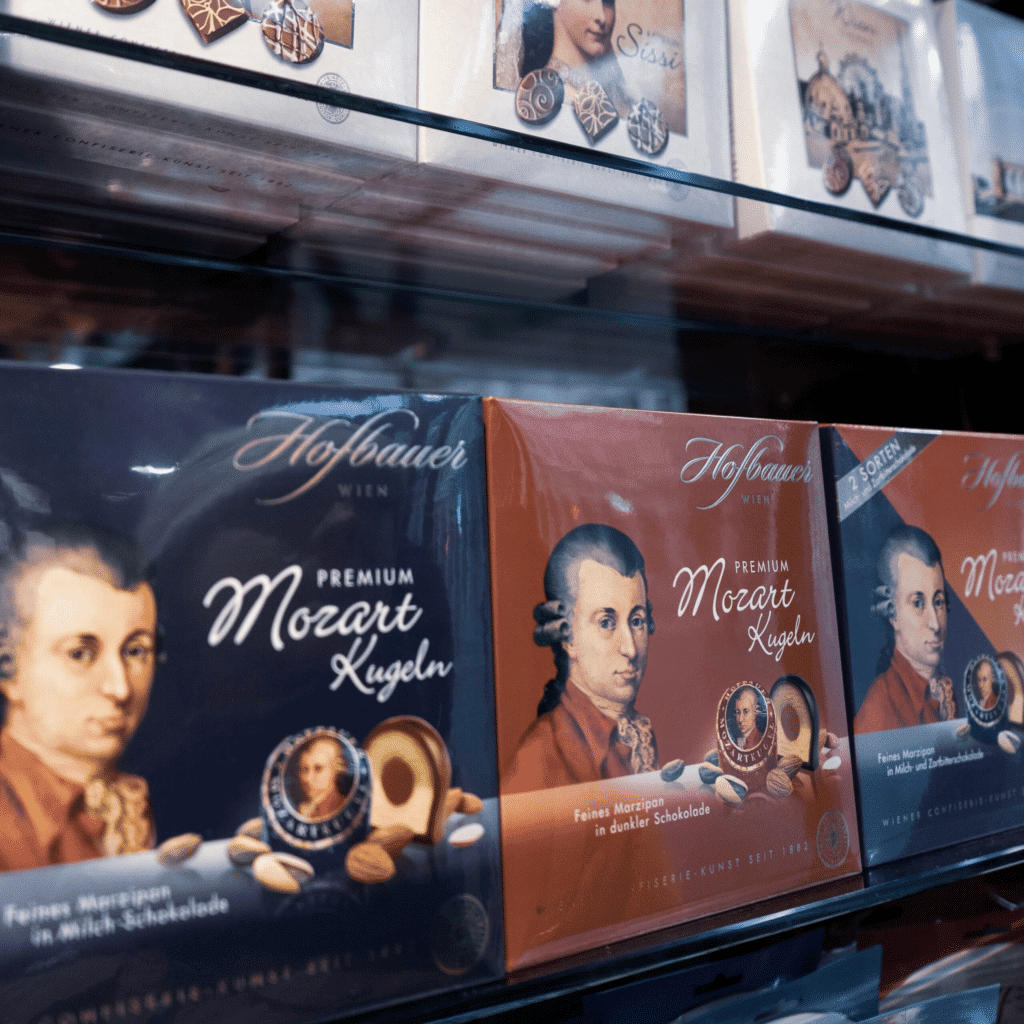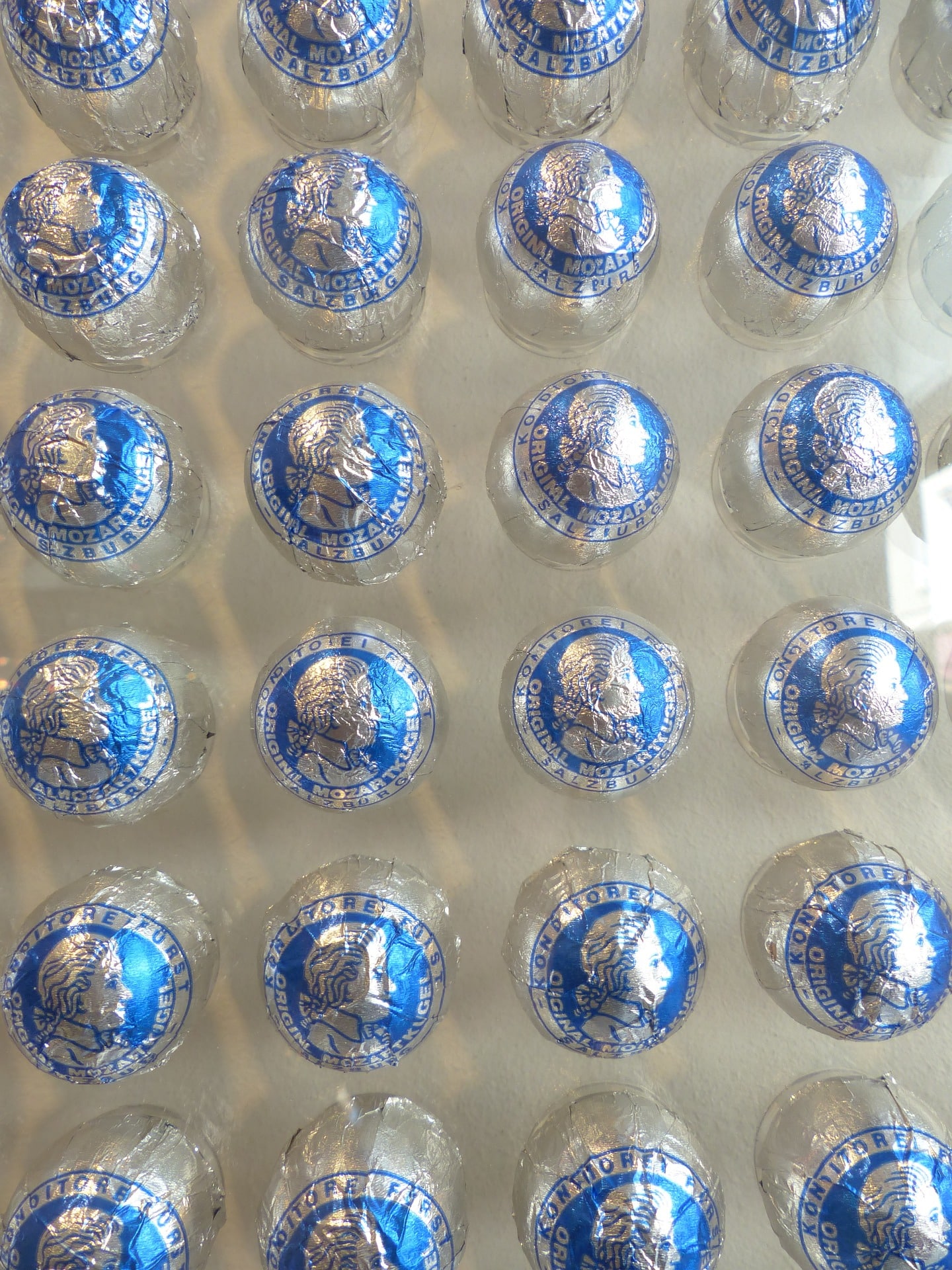Mozartkugeln – Have you ever heard about the Mozart Balls? Don’t worry, it’s nothing rough! If you’ve been to Austria or if any of your friends have been there, you’ve surely heard of Mozart Balls, those chocolate-covered bonbons filled with marzipan, wrapped with the face of that genius Wolfgang Amadeus Mozart.
Mozart Balls are in fact chocolates, but they represent the quintessential souvenir of Austria. You see shelves full of them upon arrival at the airport of Vienna and in the cities. Mozart balls, in German called “Mozartkugel” are sold in almost every Austrian city but are originally from Salzburg, the city where the greatest composer of all time was born.

History of Mozartkugeln
In the mid-1800s, the citizens of Salzburg became increasingly aware of the greatness and uniqueness of their fellow citizen recognized and appreciated throughout the world, which if exploited well could bring prestige to the city and its economy. In fact, at the end of the 1800s, the Austrian pastry chef Paul Fürst originally from Sierning, a town located in the Upper Austria, invented these rounded-shaped chocolates, with a heart of green pistachio marzipan covered with a gianduja cream, in 1884 decided to open a craft workshop in Salzburg. The confectioner presented these chocolate creations in 1890, the original name was Mozart-Bonbon, later it became MozartKugeln.
Mozart balls from the Fürst pastry shop were immediately a huge success and in 1905 they received the gold medal at the world exhibition in Paris. However, Mozart’s Balls, created in honor of the Austrian composer Wolfgang Amadeus Mozart a century after his death, are the subject of numerous imitations. Paul Fürst, the creator, never registered them. It created a dispute between those who produced the Mozartkugeln and those who claimed their paternity.
A battle that didn’t concern the recipe but the exclusive sales and export rights, the type and color of the packaging, the denomination of “Mozartkugel” and the additions of “true”, “original” and “Salzburger”. The fight for Mozart’s balls ended in 1996 when Norbert Fürst, the inventor’s great-grandson, won a lawsuit against a renowned manufacturer and managed to obtain the “Original Salzburger Mozartkugeln” attribute for his product. Attribute of which the Fürst family is more than proud.
You will never find the “Original Salzburger Mozartkugeln” outside of Salzburg but only in their four pastry shops scattered around the city center and located on Alter Markt, Mirabellplatz, Ritzerbogen and Getreidegasse.

Facts about the industrial company Mirabell
Mirabell is the largest distributor of industrially produced Mozartkugeln in Austria. These, like all the others industrially produced, don’t follow the original recipe, but are based on variations. They are smaller in volume than the original. Despite this it’s very close to the original since Mirabell was the first in the industrial world to be able to produce a fully round Mozartkugeln. The Mirabell brand infact is the only industrial manufacturer authorized to sell concentric spheres. All other manufacturers have to make their balls slightly flattened.
The Mirabell Mozartkugeln were the only Mozart balls ever taken into space. The first Austrian astronaut, Franz Viehböck, gave them as a gift to Russian cosmonauts on the MIR space station. They are not only a delicious chocolate speciality, they are a marvellous prop for small film roles on television. In the romantic television film “Laura’s List of Wishes”, the main charachter “Laura” visited the Mirabell production in Salzburg.

The original recipe
Paul Fürst always prepared Mozart’s Balls in the same way. The Austrian pastry chef never changed the original recipe, he started by modeling the pistachio marzipan and forming small balls which he covered with gianduia cream, then he stuck them on a wooden stick and dipped them in dark chocolate. Once the chocolate had hardened, he would remove the stick and cover the small hole with more dark chocolate, then cover the pralines with silver and blue aluminum foil. The pastry shop still follows the tradition and produces around 1.4 million Mozartkugeln every year. Paul Fürst’s “Original Salzburger Mozartkugel” are still expertly handmade at the Konditorei Fürst according to the original traditional recipe.

Here you can find more informations if you want to know more: https://www.mozartkugel.at/



